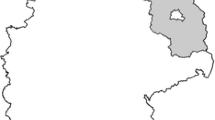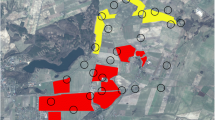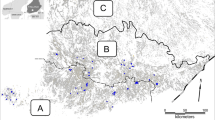Abstract
The increasing cultivation of energy crops in Germany substantially affects the habitat function of agricultural landscapes. Precise ex ante evaluations regarding the impacts of this cultivation on farmland bird populations are rare. The objective of this paper was to implement a methodology to assess the regional impacts of increasing energy maize cultivation on the habitat quality of agricultural lands for farmland birds. We selected five farmland bird indicator species with varying habitat demands. Using a crop suitability modelling approach, we analysed the availability of potential habitat areas according to different land use scenarios for a real landscape in Northeast Germany. The model was based on crop architecture, cultivation period, and landscape preconditions. Our results showed that the habitat suitability of different crops varied between bird species, and scenario calculations revealed an increase and a decrease in the size of the potential breeding and feeding habitats, respectively. The effects observed in scenario 1 (increased energy maize by 15 %) were not reproduced in all cases in scenario 2 (increased energy maize by 30 %). Spatial aggregation of energy maize resulted in a negative effect for some species. Changes in the composition of the farmland bird communities, the negative effects on farmland bird species limited in distribution and spread and the relevance of the type of agricultural land use being replaced by energy crops are also discussed. In conclusion, we suggest a trade-off between biodiversity and energy targets by identifying biodiversity-friendly energy cropping systems.









Similar content being viewed by others
References
Achtziger, R., Stickroth, H., Zieschank, R. (2004). Nachhaltigkeitsindikator für die Artenvielfalt-ein Indikator für den Zustand von Natur und Landschaft in Deutschland. Angewandte Landschaftsökologie Heft 63. Bad Godesberg.
Amon, T., Amon, B., Kryvoruchko, V., Zollitsch, W., Mayer, K., & Gruber, L. (2006). Biogas production from maize and dairy cattle manure—influence of biomass composition on the methane yield. Agriculture, Ecosystems and Environment, 118, 173–182.
Anderson, G. Q. A., & Fergusson, M. J. (2006). Energy from biomass in the UK: sources, processes and biodiversity implications. Ibis, 148, 180–183.
Anderson, G. Q. A., Haskins, L. R., & Nelson, S. H. (2004). The effects of bioenergy crops on farmland birds in the UK: a review of current knowledge and future predictions. In K. Parris & T. Poincet (Eds.), Biomass and agriculture; sustainability, markets and policies (pp. 199–218). Paris: OECD.
Atkinson, P. W., Buckingham, D., & Morris, A. J. (2004). What factors determine where invertebrate-feeding birds forage in dry agricultural grasslands? Ibis, 146(Supplement 2), 99–107.
Bastian, A., & Bastian, H.-V. (1996). Das Braunkehlchen. Wiesbaden: Opfer der ausgeräumten Kulturlandschaft.
Bauer, H.-G., & Berthold, P. (1996). Die Brutvögel Mitteleuropas. Wiesbaden: Bestand und Gefährdung.
Bauer, A., Leonhartsberger, C., Bösch, P., Amon, B., Friedl, A., & Amon, T. (2010). Analysis of methane yields from energy crops and agricultural by-products and estimation of energy potential from sustainable crop rotation systems in EU-27. Clean Technologies and Environmental Policy, 12, 153–161.
Bellamy, P. E., Croxton, P. J., Heard, M. S., Hinsley, S. A., Hulmes, L., Hulmes, S., Nuttall, P., Pywell, R. F., & Rothery, P. (2009). The impact of growing miscanthus for biomass on farmland bird populations. Biomass and Bioenergy, 33(2), 191–199.
Benton, T. G., Vickery, J. A., & Wilson, J. D. (2003). Farmland biodiversity: is habitat heterogeneity the key? Trends in Ecology and Evolution, 18(4), 182–188.
Bezzel, E. (1993). Kompendium der Vögel Mitteleuropas. Wiesbaden: Passeres-Singvögel.
Bird Life International (2012). Wild Bird Indices: tracking trends in the condition of habitats. http://www.birdlife.org/action/science/indicators/common_birds.html. Accessed 11 Sept 2012.
BMU-Federal Ministry for the Environment, Nature Conservation and Nuclear Safety (2007). National strategy on biological diversity.
BMU—Federal Ministry for the Environment, Nature Conservation and Nuclear Safety (2010). Indikatorenbericht 2010 zur Nationalen Strategie zur biologischen Vielfalt. Berlin.
Bradbury, R. B., Hill, R. A., Mason, D. C., Hinsley, S. A., Wilson, J. D., Balzter, H., Anderson, G. Q. A., Whittingham, M. J., Davenport, I. J., & Bellamy, P. E. (2005). Modelling relationships between birds and vegetation structure using airborne LiDAR data: a review with case studies from agricultural and woodland environments. Ibis, 147, 443–452.
Butler, S. J., & Gillings, S. (2004). Quantifying the effects of habitat structure on prey detectability and accessibility to farmland birds. Ibis, 146(Supplement 2), 123–130.
Butler, S. J., Boccaccio, L., Gregory, R. D., Vorisek, P., & Norris, K. (2010). Quantifying the impact of land-use change to European farmland bird populations. Agriculture, Ecosystems and Environment, 137, 348–357.
Chamberlain, D. E., Wilson, A. M., Browne, S. J., & Vickery, J. A. (1999). Effects of habitat type and management on the abundance of skylarks in the breeding season. Journal of Applied Ecology, 36, 856–870.
Cornelissen, S., Koper, M., & Deng, Y. Y. (2012). The role of bioenergy in a fully sustainable global energy system. Biomass and Bioenergy, 41, 21–33.
Dauber, J., Jones, M. B., & Stout, J. C. (2010). The impact of biomass crop cultivation on temperate biodiversity. GCB Bioenergy, 2, 289–309.
DMK (Deutsches Maiskomitee e.V.) (2012). Bedeutung des Maisanbaues in Deutschland. Statistik. http://www.maiskomitee.de/web/public/Fakten.aspx/Statistik/Deutschland. Accessed 11 Sept 2012.
Donald, P. F., Green, R. E., & Heath, M. F. (2001). Agricultural intensification and the collapse of Europe’s farmland bird populations. Proceedings of the Royal Society B, 268, 25–29.
Donald, P. F., Sanderson, F. J., Burfield, I. J., & van Bommel, F. P. J. (2006). Further evidence of continent-wide impacts of agricultural intensification on European farmland birds, 1990–2000. Agriculture, Ecosystems and Environment, 116, 189–196.
Dziewiaty, K., & Bernardy, P. (2007). Auswirkungen zunehmender Biomassenutzung (EEG) auf die Artenvielfalt-Erarbeitung von Handlungsempfehlungen für den Schutz der Vögel der Agrarlandschaft. Seeburg: Endbericht Nawaros—Vogelschutz.
Eglington, S. M., Gill, J. A., Bolton, M., Smart, M. A., Sutherland, W. J., & Watkinson, A. R. (2008). Restoration of wet features for breeding waders on lowland grassland. Journal of Applied Ecology, 45, 305–314.
Engel, J., Huth, A., & Frank, K. (2012). Bioenergy production and Skylark (Alauda arvensis) population abundance—a modelling approach for the analysis of land-use change impacts and conservation options. GCB Bioenergy, 4(6), 713–727.
Eurostat (2012). Farmland bird index. http://epp.eurostat.ec.europa.eu/portal/page/portal/product_details/dataset?p_product_code=TSIEN170. Accessed 11 Sept 2012.
Flade, M., Placher, H., Henne, E., & Anders, K. (2003). Naturschutz in der Agrarlandschaft. Wiebelsheim: Ergebnisse des Schorfheide-Chorin-Projektes.
Fritsche, U. R., Dehoust, G., Jenseit, W., Hünecke, K., Rausch, L., Schüler, D., Wiegmann, K., Heinz, A., Hiebel, M., Ising, M., Kabasci, S., Unger, C., Thrän, D., Fröhlich, N., Scholwin, F., Reinhardt, G., Gärtner, S., Patyk, A., Baur, F., Bemmann, U., Gross, B., Heib, M., Ziegler, C., Flake, M., Schmehl, M., & Simon, S. (2004). Stoffstromanalyse zur nachhaltigen energetischen Nutzung von Biomasse. Darmstadt: Öko-Institut e.V.-Institute of Applied Ecology.
Fuchs, S. & Matthews, A. (2008). Data collection avifauna. Unpublished.
Fuchs, S. & Stein-Bachinger, K. (2008). Nature conservation in organic agriculture—a manual for arable organic farming in north-east Germany. www.bfn.de.
Furness, R. W. & Greenwood, J. J. D. (1993). Birds as monitors of environmental change. London.
Gevers, J., Høye, T. T., Topping, C. J., Glemnitz, M., & Schröder, B. (2011). Biodiversity and the mitigation of climate change through bioenergy: impacts of increased maize cultivation on farmland wildlife. GCB Bioenergy, 3, 472–482.
Gregory, R. D., Vořišek, P., Noble, D. G., Van Strien, A., Klvaňová, A., Eaton, M., Gmelig Meyling, A. W., Joys, A., Foppen, R. P. B., & Burfileld, I. J. (2008). The generation and use of bird population indicators in Europe. Bird Conservation International, 18, S223–S244.
Guerrero, I., Morales, M. B., Oñate, J. J., Geiger, F., Berendse, F., De Snoo, G., Eggers, S., Pärt, T., Bengtsson, J., Clement, L. W., Weisser, W. W., Olszewski, A., Ceryngier, P., Hawro, V., Liira, J., Aavik, T., Fischer, C., Flohre, A., Thies, C., & Tscharntke, T. (2012). Response of ground-nesting farmland birds to agricultural intensification across Europe: landscape and field level management factors. Biological Conservation, 152, 74–80.
Gustavsson, L., Holmberg, J., Dornburg, V., Sathre, R., Eggers, T., Mahapatra, K. & Marland, G. (2007). Using biomass for climate change mitigation and oil use reduction. Energy Policy, 35, 5671–5691
Hoffmann. J., Berger, G., Wiegand, I., Pfeffer, H., Kiesel, J. Ehlert, F. (2012). Bewertung und Verbesserung der Biodiversität leistungsfähiger Nutzungssysteme in Ackerbaugebieten unter Nutzung von Indikatorvogelarten, Report from the Julius Kühn-Institut, 163, Federal Research Centre for Cultivated Plants, Braunschweig, Germany.
Huston, M. A., & Marland, G. (2003). Carbon management and biodiversity. Journal of Environmental Management, 67, 77–86.
Jackson, A. L. R. (2011). Renewable energy vs. biodiversity: policy conflicts and the future of nature conservation. Global Environmental Change, 21(4), 1195–1208.
Kivelitz, H., & Lütke Entrup, N. (2010). Prägt der Maisanbau immer starker das Landschaftsbild? Acker+Plus, 10, 50–56.
Kooiker, G. & Buckow, C. V. (1997). Der Kiebitz: Flugkünstler im offenen Land. Wiesbaden.
Latus, C., Schultz, A., & Kujawa, K. (2004). Occurrence of the Red-backed Shrike (Lanius collurio) depends on natural factors and mode of land use in the Quillow catchment, Germany. Biological Letters, 41(2), 87–93.
Meyer, B. C., Kerstin Mammen, K., & Grabaum, R. (2007). A spatially explicit model for integrating species assessments into landscape planning as exemplified by the corn bunting (Emberiza calandra). Journal for Nature Conservation, 15, 94–108.
Milsom, T. P., Hart, J. D., Parkin, W. K., & Peel, S. (2002). Management of coastal grazing marshes for breeding waders: the importance of surface topography and wetness. Biological Conservation, 103, 199–207.
Pätzold, R. (1994). Die Lerchen der Welt. Magdeburg.
PECBMS. (2009). The state of Europe’s common birds 2008. Prague: CSO/RSPB.
Petersen, J. E. (2008). Energy production with agricultural biomass: environmental implications and analytical challenges. European Review of Agricultural Economics, 35, 385–408.
Ryslavy, T., & Mädlow, W. (2008). Rote Liste und Liste der Brutvögel des Landes Brandenburg 2008. Naturschutz und Landschaftspflege in Brandenburg, 17, 3–104.
Schlaepfer, M. A., Runge, M. C., & Sherman, P. W. (2002). Ecological and evolutionary traps. Trends in Ecology & Evolution, 17(10), 474–480.
Schmidt, R., & Diemann, R. (1981). Erläuterung zur Mittelmaßstäbigen Landwirtschaftlichen Standortkartierung (MMK), Akademie der Landwirtschaftswissenschaften der DDR. Eberswalde: Bereich Bodenkunde/Fernerkundung.
Schümann, K., Engel, J., Frank, K., Huth, A., Luick, R., Wagner, F. (2010). Naturschutzstandards für den Biomasseanbau. Ergebnisse des gleichnamigen F + E-Vorhabens (FKZ 3507 82–150). Bonn–Bad Godesberg: Bundesamt für Naturschutz (BfN).
Toepfer, S., & Stubbe, M. (2001). Territory density of the Skylark (Alauda arvensis) in relation to field vegetation in central Germany. Journal of Ornithology, 142, 184–194.
Topping, C. J., Hansen, T. S., Jensen, T. S., Jepsen, J. U., Nikolajsen, F., & Odderskær, P. (2003). ALMaSS, an agent-based model for animals in temperate European landscapes. Ecological Modelling, 167, 65–82.
Vetter, A., Strauß, C., Nehring, A., Herrmann, C., Willms, M., Glemnitz, M. (2010): EVA sucht geeignete Anbausysteme. Biogas Journal. pp 14–17.
Whittingham, M. J., & Evans, K. L. (2004). The effects of habitat structure on predation risk of birds in agricultural landscapes. Ibis, 146(Supplement 2), 210–220.
Wilson, J. D., Evans, J., Browne, S. J., & King, J. R. (1997). Territory distribution and breeding success of skylarks Alauda arvensis on organic and intensive farmland in Southern England. Journal of Applied Ecology, 34, 1462–1478.
Wilson, J. D., Whittingham, M. J., & Bradbury, R. B. (2005). The management of crop structure: a general approach to reversing the impacts of agricultural intensification on birds? Ibis, 147, 453–463.
Wretenberg, J., Lindström, Å., Svensson, S., Thierfelder, T., & Pärt, T. (2006). Population trends of farmland birds in Sweden and England: similar trends but different patterns of agricultural intensification. Journal of Applied Ecology, 43, 1110–1120.
Wretenberg, J., Lindström, Å., Svensson, S., & Pärt, T. (2007). Linking agricultural policies to population trends of Swedish farmland birds in different agricultural regions. Journal of Applied Ecology, 44, 933–941.
Zeijts, H. van, Overmars, K., Bilt, W. van der, Schulp, N., Notenboom, J., Westhoek, H., Helming, J., Terluin, I., Janssen, S. (2011). Greening the common agricultural policy: impacts on farmland biodiversity on an EU scale. The Hague: PBL Netherlands Environmental Assessment Agency. PBL report 500136005.
Author information
Authors and Affiliations
Corresponding author
Rights and permissions
About this article
Cite this article
Brandt, K., Glemnitz, M. Assessing the regional impacts of increased energy maize cultivation on farmland birds. Environ Monit Assess 186, 679–697 (2014). https://doi.org/10.1007/s10661-013-3407-9
Received:
Accepted:
Published:
Issue Date:
DOI: https://doi.org/10.1007/s10661-013-3407-9




